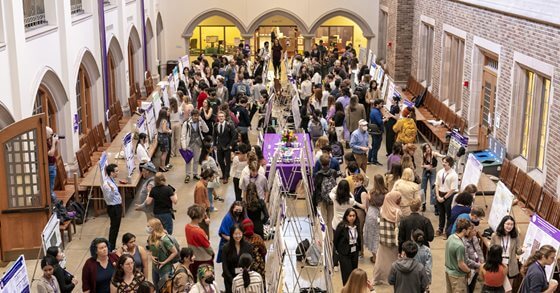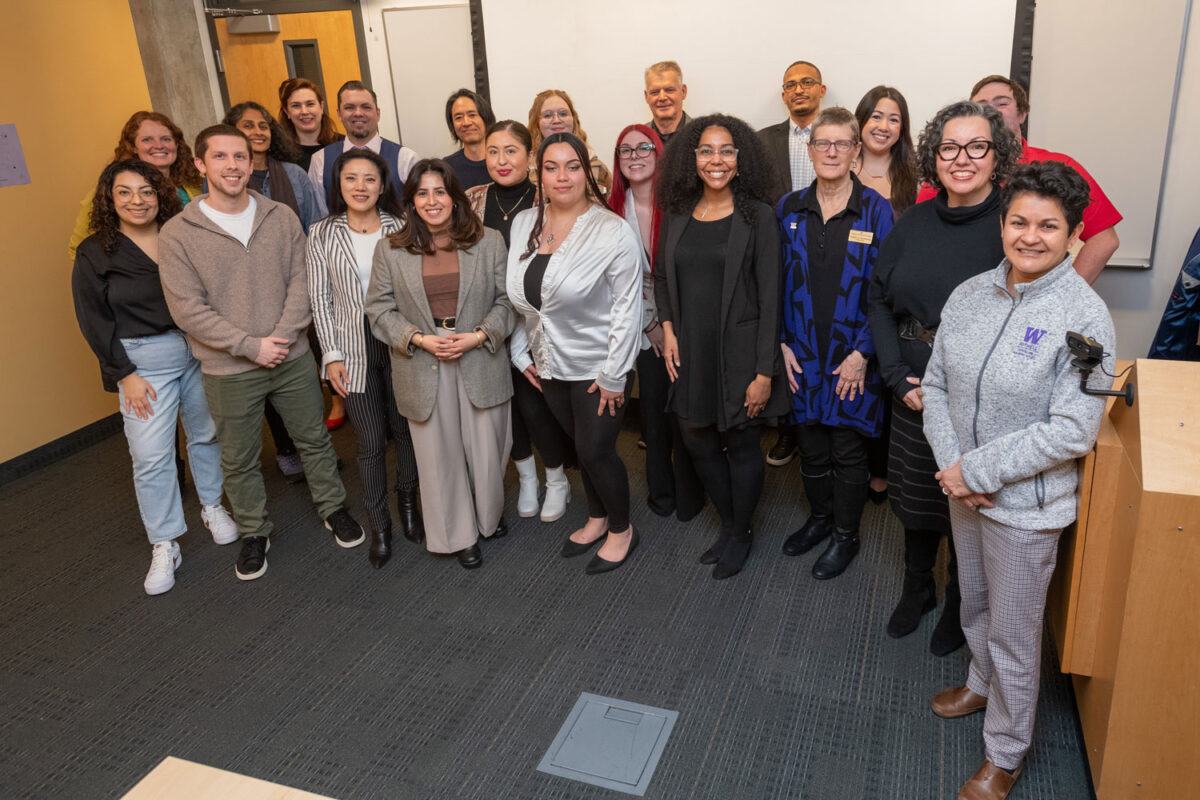More than 30 students from the University of Washington Bothell presented at the 26th Annual Undergraduate Research Symposium held at UW’s Mary Gates Hall in Seattle on Friday, May 19.
This year’s symposium hosted presentations by undergraduates from across the three UW campuses. The UW Bothell students presented 20 different research projects and topics, ranging from “Nostalgic Analysis of Tweets During Crisis Events” to “Motivation in Non-Profit Organization Workers.”
The symposium featured research across a wide array of academic disciplines — from business to STEM — with the projects covering data and information from as far away as black holes in other galaxies to as close as the UW Bothell’s campus wetland.

In opening remarks for the symposium, Ed Taylor, UW’s vice provost and dean of undergraduate affairs, also recognized the faculty support that makes this depth and breadth of student research possible. He then announced and congratulated seven recipients of the annual Outstanding Undergraduate Research Mentor Awards — including Dr. Paola Rodríguez Hidalgo, an assistant professor in UW Bothell’s School of STEM.
Supporting their students
Students presenting in the symposium each year can nominate mentors who have had a profound impact on their education and research. A small committee of faculty and staff then reviews the nominations to select the award recipients.
“It was one of the most beautiful awards,” Rodríguez Hidalgo said. “It’s nice being recognized by the University, but it’s also thanks to my students — and that’s just so beautiful.”
She was nominated by two students from her quasar research group, Easton Robert Pierce and Alex Vong.
“Paola has been an amazing mentor. She has consistently pushed me to go beyond and motivated me to continue even when I’ve hit a wall,” said Pierce in his nomination for Rodríguez Hidalgo.
“Between her meetings, giving talks and writing papers, I’m not sure where she finds the time for it all,” he said. “She truly deserves to be recognized for all the hard work she puts into not only teaching classes but also mentoring students and leading the quasar research group.”
Understanding stars in the universe
Pierce is a senior majoring in physics at UW Bothell. He first developed a love of astronomy when his parents bought him a starter telescope when he was 9 years old. He is now a NASA Space Grant scholar.
“What drew me to astronomy is the pure absurdity of the scale and energies of the objects in which we study,” he said.
At this year’s symposium, Pierce presented “Variability in Extremely High Velocity Outflows.” Quasars are a phenomenon where gas and dust from extremely luminous galactic cores fall into a supermassive black hole. This can sometimes produce winds known as outflows. Whether these outflows affect the evolution of their host galaxies remains unknown and continues to be a point of interest in ongoing research.
“Because of the large energies found in extremely high velocity outflows, we believe they may play a large role in the evolution of galaxies, specifically on their ability to form stars,” Pierce said.
Looking at ancient fires and fuels
In her presentation, “Validating Fossil Charcoal Morphometry as a Tool for Determining Fuel Types of Ancient Fires,” Haley Brooks (Conservation & Restoration Science ’23) sampled 34 modern plant species from UW Herbarium collections to study charcoal morphometry — the measurement of sedimentary charcoal particle shape attributes — after burning the samples at 500 degrees Celsius.
Brooks investigated if charcoal aspect ratio is a valid method for determining fuel type. If this method can be used when looking at modern-day plants, she noted, it may provide important insights into ancient fire regimes. Her mentors for this research were both in the UW’s Department of Biology on the Seattle campus: Dr. Caroline Strömberg, professor; and Dr. Christopher Schiller, postdoctoral scholar.
With the rapidly changing climate, Brooks said it’s become a priority to gain a better understanding of how the changes will affect plant life to strategize conservation practices for the near future. “We’re in a climate crisis right now where we’ve never been in this climate zone, but the world has previously.
“So if we’re able to look at the climate zones of ancient fires and look at what burned at that time,” she said, “we can put that into our conservation practices and have retroactive success in protecting those plant species that are used for fuel — before it happens.”
Brooks noted in her presentation that continued research into the verification of charcoal morphometry as a means to verify fuel type could also help increase confidence in paleo reconstructions of ancient fuel types.
Examining learning during the pandemic
In his project, “Concept Models show the Impact of the COVID-19 Disruption on Students’ Cognitive Structures in a Statistics Course,” Eric Yoon Jae Shin analyzed student learning in a statistics course in both a pre-pandemic and pandemic setting. Dr. Caleb Trujillo, assistant professor in the School of Interdisciplinary Arts & Sciences, oversaw this research as Shin’s mentor.
“The main thing we wanted to find out was whether or not the COVID-19 disruptions affected students learning,” Shin said, a senior majoring Mathematical Thinking & Visualization.
Searching for answers, he looked to concept models — hand drawn models students use to write statistics concepts — to measure student learning. He analyzed 180 models from two different experiences and quarters: an in-person learning environment in a pre-pandemic quarter and an online learning environment during the pandemic.
“The key finding that we made was that students in the online quarter were adding concepts to their models at a lower rate than students in the previous quarter, which was before the coronavirus pandemic,” Shin said. “We came to the conclusion that the COVID-19 disruption had a major impact on a student’s learning in the statistics course.”
What makes this kind of research so important, Shin noted, is that it can be used by professors to better understand and assist college students as they learn in different spaces.
Discovering the possibilities
The presentations in this year’s symposium represent the broad range of research, scholarship and creative practice projects that students can undertake during their undergraduate studies.
Here is a small sampling of additional oral, poster and visual arts presentations UW Bothell students gave at this year’s symposium:
- “Fairness and Biases in Mobility Models”
- presented by Daniel Wang, a senior in Computer Science & Software Engineering; mentored by Dr. Afra Mashhadi, assistant professor, School of STEM
- “Missing Maps: Identifying Remote Communities Using Satellite Imagery and Machine Learning”
- presented by Inkar Kapen, a senior in Computer Science & Software Engineering and a Mary Gates Scholar; mentored by Dr. Afra Mashhadi, assistant professor, School of STEM
- “The Effect of Advanced Age and Alzheimer’s Disease Neuropathology on Levels of the Tight Junction Protein, Occludin, in the Brain Microvasculature”
- presented by Ali Mirzazadeh, a senior in Biology; mentored by Dr. May Reed, associate professor in the UW’s Department of Medicine, Division of Gerontology and Geriatric Medicine
A complete list of the research projects presented by UW Bothell students this year can be found on the UW’s Undergraduate Research Symposium website.



